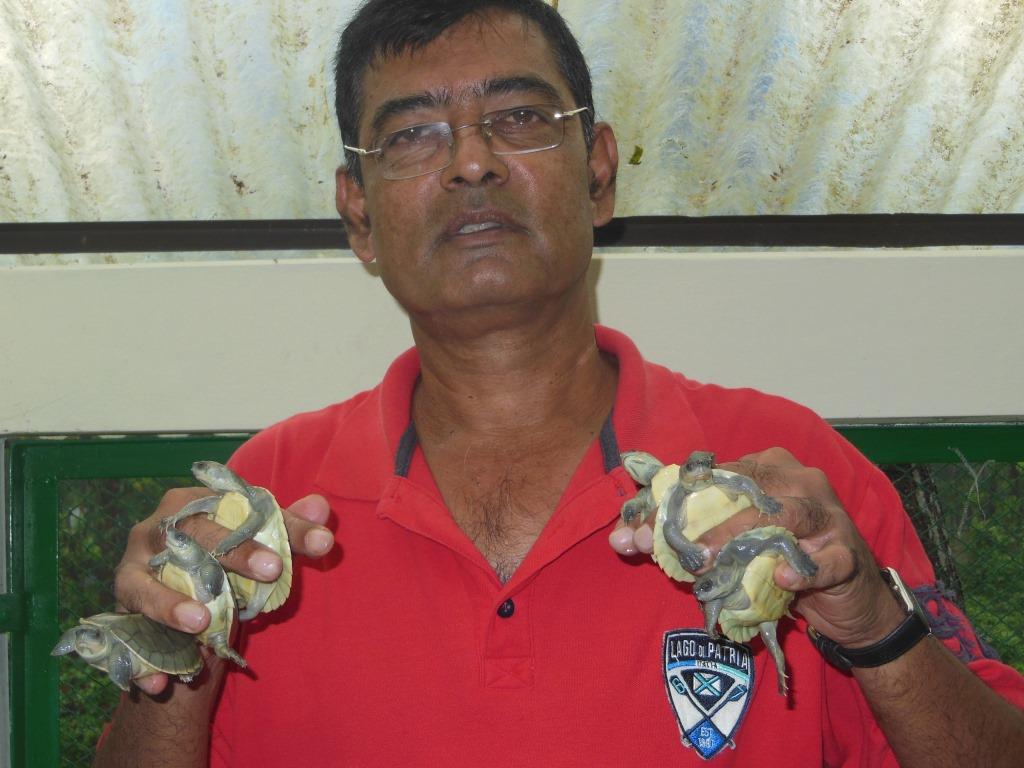World’s Fourth Most Endangered Turtles Hatch
by Heather Lowe 
For the second consecutive year the world's known population of the Northern River Terrapin, or Sundarbans Batagur (Batagur baska), has more than doubled. Last year we reported on our first significant breeding successes of this critically endangered turtle, with 50 hatchlings produced at TSA supported breeding facilities in both Bangladesh and India (click here for details). This year the TSA is pleased to report the successful hatching of 117 B. baska, 61 in Bangladesh and 56 in India.
 This species underwent a rapid decline over the past twenty years due to chronic egg collection and harvesting of adults for food, and was considered nearly extinct in the wild with no nesting populations known. Ranked #4 on the 2011 list of the World's 25 Most Endangered Tortoises and Freshwater Turtles, the prospects for this species' recovery are much brighter today thanks to aggressive conservation intervention and the establishment of in situ captive breeding colonies. Those programs will see significant expansion over the next two years with funding from an SOS – Save Our Species grant, which will include building additional breeding ponds at the site in Bangladesh to allow for more controlled breeding and genetic management, surveys to try and locate remnant populations and potential release sites, and acquiring new adults for the breeding program. It is important to note that this program – at least in Bangladesh - was built by acquiring long-term captive terrapins that were kept for years in isolated home and village ponds as an egg source, survivors from a time when the species was more common.
This species underwent a rapid decline over the past twenty years due to chronic egg collection and harvesting of adults for food, and was considered nearly extinct in the wild with no nesting populations known. Ranked #4 on the 2011 list of the World's 25 Most Endangered Tortoises and Freshwater Turtles, the prospects for this species' recovery are much brighter today thanks to aggressive conservation intervention and the establishment of in situ captive breeding colonies. Those programs will see significant expansion over the next two years with funding from an SOS – Save Our Species grant, which will include building additional breeding ponds at the site in Bangladesh to allow for more controlled breeding and genetic management, surveys to try and locate remnant populations and potential release sites, and acquiring new adults for the breeding program. It is important to note that this program – at least in Bangladesh - was built by acquiring long-term captive terrapins that were kept for years in isolated home and village ponds as an egg source, survivors from a time when the species was more common.
At the Bhawal National Park facility near Dhaka, Bangladesh, facility manager A.G.J. Morshed reports that hatching began on 23 May, and that four clutches of eggs have produced 61 hatchlings. A fifth clutch was determined to be infertile. In total all five females in the breeding group laid a total of 99 eggs. Improvements to hatching success this year can be attributed to closer monitoring of temperatures during incubation, and keeping the nests protected from rain saturation. Stringent efforts were made to ensure that temperatures in the nest chamber were sufficiently high to produce females. This program is supported by the TSA and Vienna Zoo, in collaboration with the Bangladesh Forest Department, IUCN Bangladesh, CARINAM and our media partner Prokriti O Jibon. Special thanks are extended to Rupali Ghosh, Peter Praschag, Toni Weissenbacher and Brian Horne for their careful monitoring of the situation, both remotely and on site. Toronto Zoo is also recognized for their financial support.
TSA India Director Shai Singh reports that 56 hatchlings emerged at the Batagur breeding facility at on the night of 25 May, and a few more hatchlings are expected. The breeding center is located at the Sundarbans Tiger Reserve at Sajnekhali, in West Bengal. Shai will be going there the first week of June to inspect juvenile set ups and to make husbandry recommendations. This program is supported by TSA India, and managed in collaboration with the West Bengal Forest Department. Special thanks are extended to West Bengal Forest Department and their officers especially - Mr SB Madal,IFS, Mr Soumitra Dasgupta, IFS, Mr Jayanto Basu, Mr Bhaumik and Dr Gowri Mallapur - to make the project a success.
